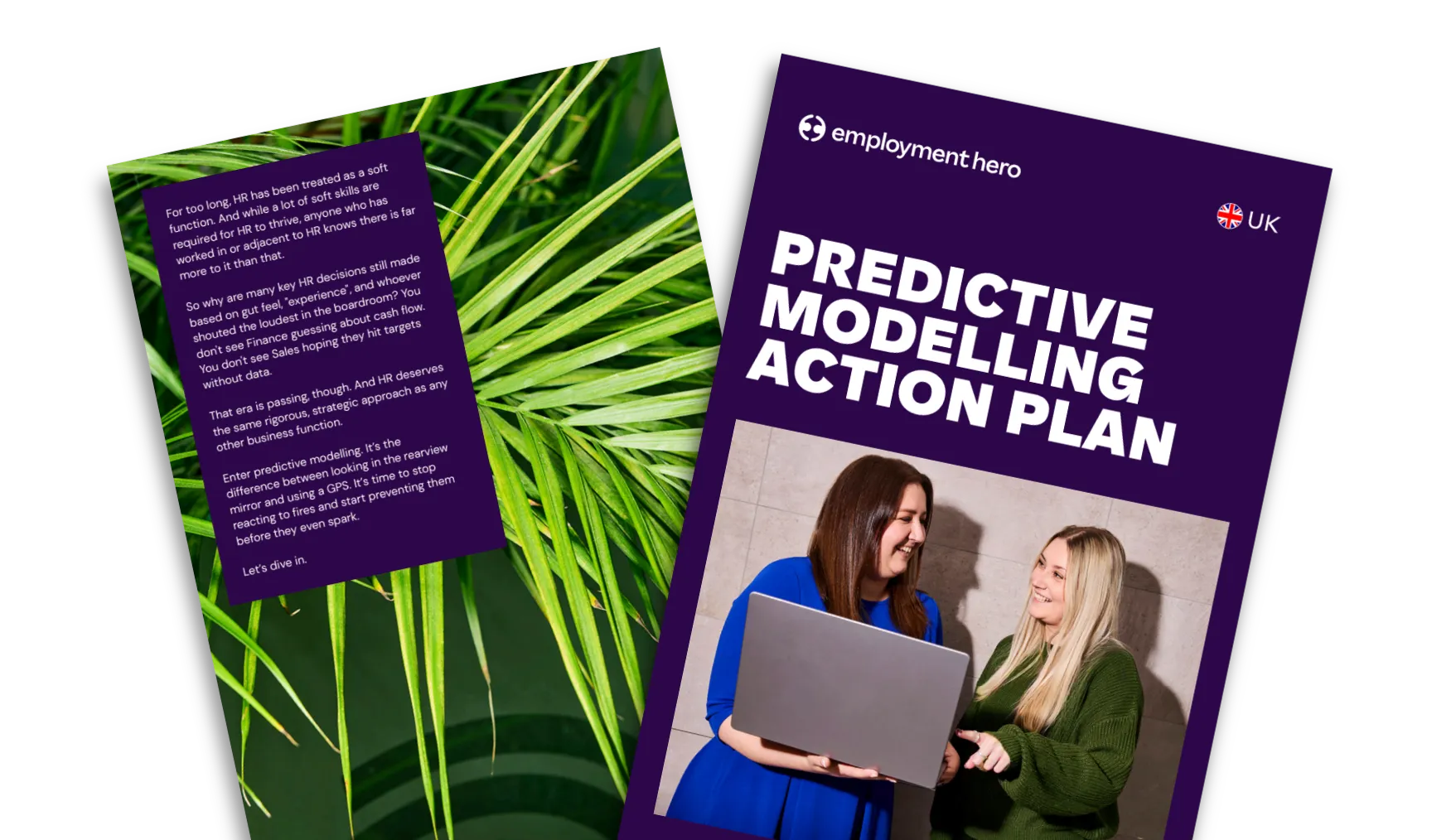Employee Reward and Recognition Guide
Published
Employee Reward and Recognition Guide
Reward and recognition in the workplace is essential for modern businesses. By now, business owners, leaders and HR managers are aware that creating a thriving workplace isn’t just about offering competitive salaries or modern office perks. Instead, it’s about building a culture where your people feel valued, motivated and connected to their work.
The most powerful way of doing this? Through a strong employee recognition strategy.
When organisations prioritise employee recognition alongside thoughtful reward systems, they create an environment where effort and achievement are not only noticed but celebrated. This combination fuels engagement, strengthens loyalty and drives long-term success.
Want to learn how your business can up its reward and recognition game? You’ll find it all in our free guide.
Who is the reward and recognition guide for?
This guide is designed for:
- Business owners and leaders
- HR professionals
- Managers
What’s inside?
The Reward and Recognition Guide covers:
- What is reward and recognition?
- How to create a culture of reward and recognition in the workplace
- Different ways you can show appreciation in your team
- Putting it all together – how to create a meaningful recognition strategy
What are rewards and recognition in the workplace?
At their core, employee rewards and recognition are two complementary ways of showing your team that their contributions matter.
While often used together, they are not the same thing and understanding the difference is key to building a successful programme.
Defining rewards vs recognition
- Rewards: Tangible benefits or incentives given to employees, often tied to performance or achievement. These can include monetary bonuses, gift vouchers, additional leave or experiential perks like team outings. Rewards typically have a financial or material value and are used to celebrate specific milestones or results.
- Recognition: Focuses on acknowledging and appreciating an employee’s effort, behaviours or impact. It can be as simple as a manager saying “thank you” in a one-to-one meeting, a shoutout in a team huddle or a peer-to-peer message of appreciation. Recognition is usually immediate, personal and meaningful—it doesn’t always cost money, but it has powerful emotional value.
Why both are important
When used together, employee recognition and rewards create a holistic approach to valuing staff.
While rewards deliver extrinsic motivation and give your team something to work towards, recognition provides intrinsic motivation, meeting the human need to feel valued and respected.
It’s important to keep in mind that the two work hand in hand and too much focus on one without the other can create imbalance: relying only on rewards risks feeling transactional, while relying only on recognition may not fully satisfy employees seeking tangible benefits.
Driving motivation through rewards and recognition
A well-balanced reward recognition programme has a ripple effect across the workplace. Recognition builds stronger relationships, reinforces positive behaviours and nurtures a sense of belonging. Rewards, meanwhile, act as milestones that celebrate achievement and encourage continued high performance. Together, they:
- Increase employee motivation by showing that effort leads to both appreciation and meaningful outcomes.
- Strengthen engagement by fostering trust, loyalty and emotional commitment to the organisation.
- Improve retention by making employees feel seen, valued and supported in their career journey.
By weaving rewards and recognition in the workplace into everyday culture, organisations create an environment where people are motivated not just to meet expectations—but to exceed them.
Why employee recognition matters more than ever
In today’s rapidly changing world of work, employee recognition is no longer a nice-to-have, it’s a business-critical strategy. Shifts in workforce expectations, the rise of hybrid and remote work and growing competition for talent mean that organisations must find ways to keep their people engaged, motivated and committed.
Recognition is one of the most effective levers to achieve this.
Prevents disengagement
Having an engaged team is essential for not only morale and wellbeing, but also business success.
The data is shocking. According to Gallup’s State of the Global Workplace report, only 21% of employees worldwide feel engaged at work. The report also states that disengagement can cost businesses up to 18% of an employee’s annual salary in lost productivity.
But it’s not all doom and gloom, Employment Hero’s research, Work That Works report found that when employees feel recognised, retention issues are reduced by 40%. And job satisfaction is the number one driver of employee productivity.
The data doesn’t lie, employee recognition is a huge driver for productivity and reducing disengagement. Both of which are important for achieving business objectives.
The psychological impact of recognition
Your people are your most valuable asset and employee recognition taps into a fundamental human need: to feel valued and appreciated.
When your team receives genuine recognition, it reinforces their sense of self-worth and belonging. This positive reinforcement has a variety of positive impacts, including:
- Boosted morale
- Encourages discretionary effort
- Reduced stress.
The opposite is the case when employees feel invisible or underappreciated, motivation quickly declines, leading to frustration, burnout or eventual resignation.
Recognition drives organisational outcomes
Beyond individual well-being, the recognition of staff has measurable benefits for organisations. Companies with strong recognition cultures report:
- Higher employee engagement and satisfaction scores.
- Improved retention rates and reduced absenteeism.
- Stronger alignment with organisational values and goals.
- Enhanced performance and productivity, as employees are motivated to go the extra mile.
In short, employee recognition is more than a feel-good initiative, it’s something that improves your bottom line. In a competitive talent market, the organisations that prioritise meaningful recognition will not only keep their best people but also inspire them to perform at their best.
Common types of employee rewards and recognition
A strong reward and recognition system combines different methods, tailored to your culture and workforce. Below are some of the most common and effective approaches.
Monetary rewards
Tangible rewards provide immediate, measurable value and can reinforce high performance. Monetary rewards can come in the form of:
- Bonuses tied to individual, team or company results.
- Gift cards for popular retailers, restaurants or online platforms.
- Salary increases or profit-sharing schemes for sustained contributions.
Monetary compensation is often seen as highly motivating but should be paired with other forms of recognition to avoid a purely transactional culture.
Non-monetary recognition
Recognition doesn’t always need a price tag to make an impact. Thoughtful gestures can be just as meaningful as financial rewards:
- Verbal praise from a manager or colleague, either in private or during team meetings.
- Public acknowledgment in newsletters, all-hands or social channels.
- Flexible working hours or additional time off, showing trust and appreciation for employee well-being.
Experiential and social rewards
Experiences can be more memorable than material items, creating lasting positive associations:
- Team outings or lunches to celebrate success together.
- Wellness experiences, such as spa days, fitness memberships or meditation classes.
- Professional development opportunities, like courses, certifications or conference attendance.
Peer-to-peer vs. top-down recognition
Recognition can flow in different directions and both approaches matter:
- Top-down recognition: Leaders and managers acknowledging staff achievements, setting the tone for a culture of appreciation.
- Peer-to-peer recognition: Colleagues celebrating each other’s efforts, which helps foster collaboration, trust and team spirit.
A balanced reward recognition programme blends these categories, ensuring employees feel valued in multiple ways, by both leaders and peers.
Manager’s checklist for delivering meaningful recognition
Managers play a pivotal role in shaping how employees experience rewards and recognition in the workplace. Recognition doesn’t need to be elaborate, it just needs to be thoughtful, intentional and consistent. Use this checklist to ensure your recognition efforts land with impact.
Be specific, timely and consistent
- Don’t just say “Great job”—explain what the employee did and why it mattered.
- Deliver recognition as close to the achievement as possible to maximise its motivational impact.
- Make recognition part of your regular routine, not a once-in-a-while gesture.
Link praise to values and goals
- Tie recognition back to organisational values or team objectives.
- Example: “Your customer-first approach in resolving that issue directly reflects our core value of service excellence.”
- This reinforces the right behaviours and strengthens cultural alignment.
Avoid favouritism or inconsistency
- Spread recognition fairly across the team to avoid perceptions of bias.
- Make sure recognition is based on behaviours and outcomes, not personal preferences.
- Monitor frequency to ensure no one feels overlooked.
Encourage peer recognition
- Create opportunities for team members to celebrate one another, not just rely on manager feedback.
- Introduce tools, channels or rituals (like “shout-out” moments in team meetings).
- Peer-to-peer recognition fosters stronger collaboration and inclusivity.
By following this checklist, managers can turn everyday acknowledgments into meaningful moments that drive motivation, strengthen trust and make employee recognition a natural part of the workplace culture.
Download the complete rewards and recognition guide
Building a culture of appreciation doesn’t happen overnight, but with the right reward and recognition strategy, you can create a workplace where people feel truly valued, motivated and inspired to give their best. From understanding the difference between employee rewards and recognition of staff, to designing a structured programme that aligns with your culture and goals, every step makes a difference.
Frequently asked questions about recognition and rewards programmes
Rewards are tangible, often financial or material, incentives such as bonuses, vouchers or extra leave. They usually celebrate specific achievements or milestones.
Recognition is the act of acknowledging and appreciating effort, behaviour or contribution. It’s often verbal, public or written—and doesn’t necessarily involve money.In short, rewards answer the question “What do I get?”, while recognition answers “How am I valued?”. Both are essential for a balanced rewards and recognition strategy.
Examples of an effective reward system for employees include:
- Monetary rewards: Performance bonuses, profit-sharing or gift cards.
- Non-monetary rewards: Extra paid time off, flexible work schedules or development opportunities.
- Experiential rewards: Team lunches, company retreats or tickets to events.
- Career-related rewards: Sponsorship for training, conferences or certifications.
The best employee reward is one that feels meaningful, relevant and aligned with both individual and organisational goals.
To create a sustainable employee recognition programme, follow these steps:
- Understand employee preferences through surveys and feedback.
- Set clear objectives—whether boosting engagement, reducing turnover or reinforcing company values.
- Choose the right recognition methods, balancing peer-to-peer and manager-led approaches.
- Make recognition timely and specific, so employees clearly connect the praise to their actions.
- Communicate and encourage participation, ensuring recognition becomes part of everyday culture.
Measure results through engagement surveys, retention data, and participation rates.
Small businesses can reward their employees through:
- Verbal and written appreciation in team meetings or company newsletters.
- Low-cost perks, such as flexible hours, casual dress days or early finishes on Fridays.
- Personalised tokens of thanks, like handwritten notes, birthday celebrations or recognition boards.
- Development opportunities, such as mentoring, cross-training or access to online learning.
- Social experiences, like shared lunches or volunteer days.
For small businesses, the personal touch often matters most. Recognition delivered directly by leaders can feel especially meaningful and foster loyalty.
To download the guide, we just need a few quick details.
Related Resources
-
 Read more: Predictive Modelling in HR: Stop Guessing, Start Winning
Read more: Predictive Modelling in HR: Stop Guessing, Start WinningPredictive Modelling in HR: Stop Guessing, Start Winning
Discover how predictive modelling in HR can transform decision-making. Learn about key models, algorithms and steps to implement predictive analytics.
-
 Read more: Team Cohesion: The Ultimate Toolkit For Cross-Functional Collaboration
Read more: Team Cohesion: The Ultimate Toolkit For Cross-Functional CollaborationTeam Cohesion: The Ultimate Toolkit For Cross-Functional Collaboration
Learn how to build team cohesion and improve cross-functional collaboration. Discover actionable strategies, team-building activities and key behaviours.
-
 Read more: Your 60 day onboarding plan: The free template for building momentum
Read more: Your 60 day onboarding plan: The free template for building momentumYour 60 day onboarding plan: The free template for building momentum
Download a free 60 day onboarding plan template. Learn how to set clear goals, track progress and ensure new hire…



















